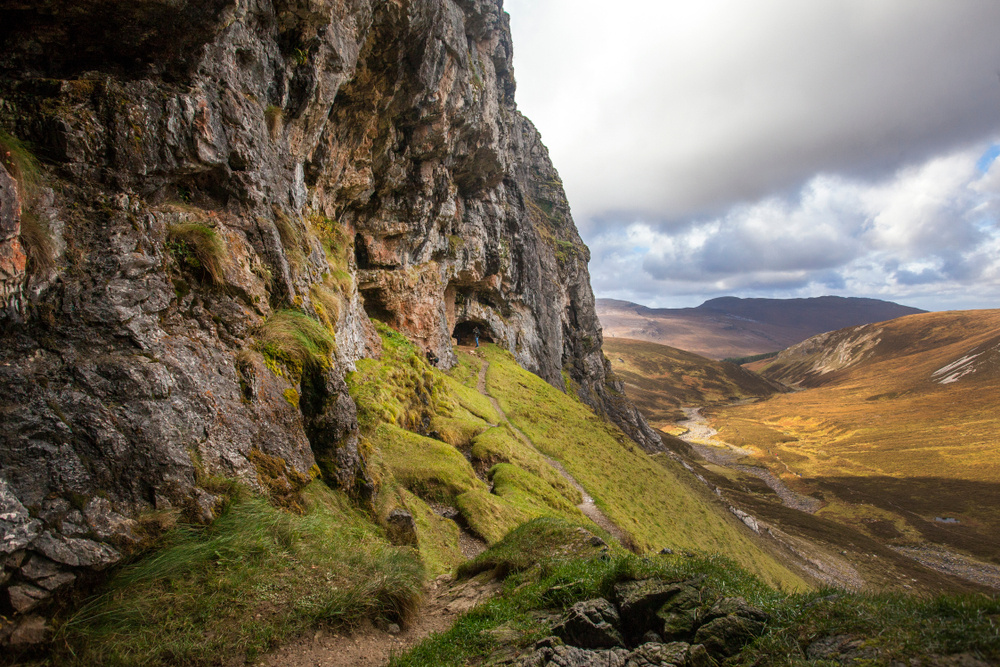
Assynt is full of hidden gems and mysteries just waiting to be discovered, none more so than the bone caves that lie a few minutes’ away by car from Inchnadamph Explorers Lodge.
The Inchnadamph Bone Caves are no ordinary caves.
They are one of the most mysterious and magical places in the highlands of Scotland. A total of four natural limestone caves sitting in the high limestone cliff walls of Creag nan Uamh (Crag of the Caves), they’re named after the large number of animal bones discovered during numerous excavations : badger, reindeer, fox’s den and bone cave.
Each of the larger caves is about 5 metres in depth and just about tall enough to stand up in. However, they can get pretty dark so we’d recommend bringing a torch with you, even during the day!
The caves that we see today are a very simple and shallow reflection of a larger cave system – over the years, the valley has gradually deepened, cutting away some of the caves, leaving what we see today as high and dry on the valley side.
Within one cave you can explore the diverse animal life (some now extinct) that once inhabited Scotland, including wolves, bears, arctic fox and even a Northern lynx – the only one ever to be found in Scotland. Finds from the caves can be found at the Royal Museum of Scotland in Edinburgh.
When were the bones discovered?
Geologists Peach and Horne first discovered the caves in 1889, who found elements of animal bone at the mouth of one of the caves. Some years later in 1928, fellow geologist J.E. Cree conducted further investigation of the caves, finding a bear tooth, human skeletons antler and more. Fascinatingly, geological evidence suggests these bones and fossils date back to an Upper Palaeolithic time.
While there is no evidence to suggest humans inhabited these caves, there are hints indicating the caves were used for human burials – with a human skull and jaw bones, and a secondary set of human bones discovered in a small stone enclosure.
How did the bones get there?
The most popular view is that the majority of bones were washed downstream as glaciers in the local area shrank. It’s also highly likely that the caves were used for hibernation too.
Visiting the bone caves
The 30-minute walk from the main road of the NC500 to the wilderness of the Allt nan Uamh (Burn of the Caves) is an unmissable stop on your Scottish Highlands holiday.
Views from the bone caves across the Scottish wilderness are exceptional. Rocks, rugged landscape and often snow-topped mountains are framed from within the caves: you’re truly in the middle of nowhere here.
It’s a great and easy day out from Inchadamph Explorers Lodge, being only a few minutes’ drive away. The path leading from the car park to the caves is quite obvious and easy-going, with panoramic views across the nearby countryside – you can even catch glimpses of Ben More Assynt on a fine day. And don’t miss Sovi’s Coffee Box if you’re there between March and October! Delicious coffee and Czech baking run by our local friend, Pavlina.
While you may not necessarily spend a great deal of time here visiting the caves, we think it’s a must-see during your holiday here in Assynt, whatever the weather!
Make sure to visit the Inchnadamph bone caves during your next holiday here
While this site is no secret to locals, it’s still quite a hidden tourist destination, and one we would highly recommend to holiday makers.
If you’re considering visiting the bone caves, why not stay at nearby Inchnadamph Explorers Lodge and enjoy home comforts in a range of accommodation to suit everyone, from shepherds huts, studio apartments, our self-catering cottage or hostel bedrooms? The best of Assynt is here on our doorstep just waiting to be discovered. Book your stay at Inchnadamph now for an unforgettable holiday.
